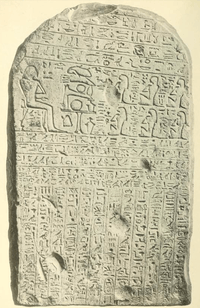Sebek-khu Stele
|
The Sebek-khu Stele in a 1914 Manchester Museum brochure | |
| Material | Limestone |
|---|---|
| Writing | Ancient Egyptian hieroglyphs |
| Created | c.1880-1840 BC |
| Discovered | 1901 |
| Present location | Manchester Museum |
| Identification | 3306 |
The Sebek-khu Stele, also known as the Stele of Khu-sobek, is an inscription in honour of a man named Khu-sobek (Sebek-khu) who lived during the reign of Senusret III (reign: 1878 – 1839 BC) discovered by John Garstang in 1901[1] outside Khu-sobek's tomb at Abydos, Egypt, and now housed in the Manchester Museum.[2][3]
The text is largely about Khu-sobek's life, and is historically important because they record the earliest known Egyptian military campaign in Canaan (or elsewhere in Asia). The text reads "Then Sekmem fell, together with the wretched Retenu", where Sekmem (s-k-m-m) is thought to be Shechem.
External links
References
This article is issued from Wikipedia - version of the Monday, September 14, 2015. The text is available under the Creative Commons Attribution/Share Alike but additional terms may apply for the media files.
